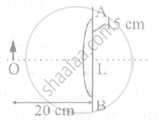Advertisements
Advertisements
प्रश्न
A light ray, going through a prism with the angle of prism 60°, is found to deviate by 30°. What limit on the refractive index can be put from these data?
उत्तर
Given,
The angle of the prism (A) = 60˚
The angle of deviation (δm) = 30˚
\[Refractive index, \]
\[ \mu \leq \frac{\sin\left( \frac{A + \delta_m}{2} \right)}{\sin\left( \frac{A}{2} \right)}\]
\[\mu \leq \frac{\sin\left( \frac{60^\circ + \delta_m}{2} \right)}{\sin\left( \frac{60^\circ}{2} \right)}\]
\[\mu \leq 2\sin\left( \frac{60^\circ\ + \delta_m}{2} \right)\]
As there is one ray that has been found which has deviated by 30˚, the angle of minimum deviation should be either equal to or less than 30˚ but it can not be more than 30˚.
Therefore,
\[\mu \leq 2\sin \left( \frac{60^\circ + \delta_m}{2} \right)\]
\[\mu \leq 2\sin \left( \frac{60^\circ \ + 30^\circ}{2} \right) = 2\sin \left( 45^\circ\ \right)\]
Refractive index (μ) will be more if angle of deviation (δm) is more.
\[\mu \leq 2 \times \frac{1}{\sqrt{2}}\]
\[\Rightarrow \mu \leq \sqrt{2}\]
Hence, the required limit of refractive index is \[\sqrt{2}\]
APPEARS IN
संबंधित प्रश्न
Calculate the distance of an object of height h from a concave mirror of radius of curvature 20 cm, so as to obtain a real image of magnification 2. Find the location of the image also.
a) Give two reasons to explain why reflecting telescopes are preferred over refracting type.
Use the mirror equation to show that an object placed between f and 2f of a concave mirror produces a real image beyond 2f.
Use the mirror equation to show that a convex mirror always produces a virtual image independent of the location of the object.
Use the mirror equation to deduce that an object placed between the pole and focus of a concave mirror produces a virtual and enlarged image.
Use the mirror equation to show that an object placed between f and 2f of a concave mirror forms an image beyond 2f.
Define the term 'limit of resolution'?
Use the mirror equation to show a convex mirror always produces a virtual image independent of the location of the object ?
The rays of different colours fail to converge at a point after going through a converging lens. This defect is called
Mark the correct options.
Which of the following (referred to a spherical mirror) do (does) not depend on whether the rays are paraxial or not?
(a) Pole
(b) Focus
(c) Radius of curvature
(d) Principal axis
A cylindrical vessel of diameter 12 cm contains 800π cm3 of water. A cylindrical glass piece of diameter 8.0 cm and height 8.0 cm is placed in the vessel. If the bottom of the vessel under the glass piece is seen by the paraxial rays (see figure), locate its image. The index of refraction of glass is 1.50 and that of water is 1.33.

Find the maximum angle of refraction when a light ray is refracted from glass (μ = 1.50) to air.
Write any one use for each of the following mirrors :
(a) Convex
(b) Concave
Name the physical principle on which the working of optical fibers is based.
For paraxial rays, show that the focal length of a spherical mirror is one-half of its radius of curvature.
A point object is placed at a distance of 20 cm from a thin plano-convex lens of focal length 15 cm, if the plane surface is silvered. The image will form at:

A parallel beam of light is allowed to fall on a transparent spherical globe of diameter 30cm and refractive index 1.5. The distance from the centre of the globe at which the beam of light can converge is ______ mm.
Car B overtakes car A at a relative speed of 40 ms-1. How fast will the image of car B appear to move in the mirror of focal length 10 cm fitted in car A, when car B is 1.9 m away from car A?
